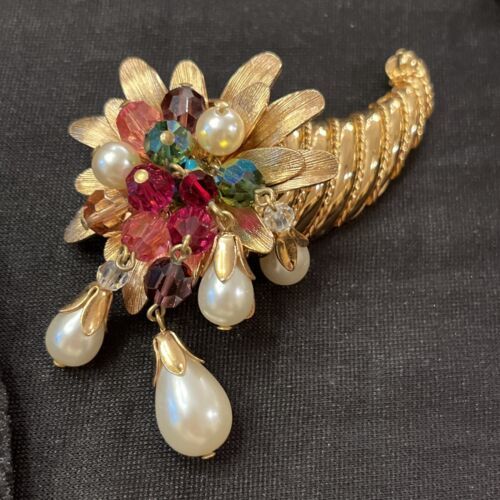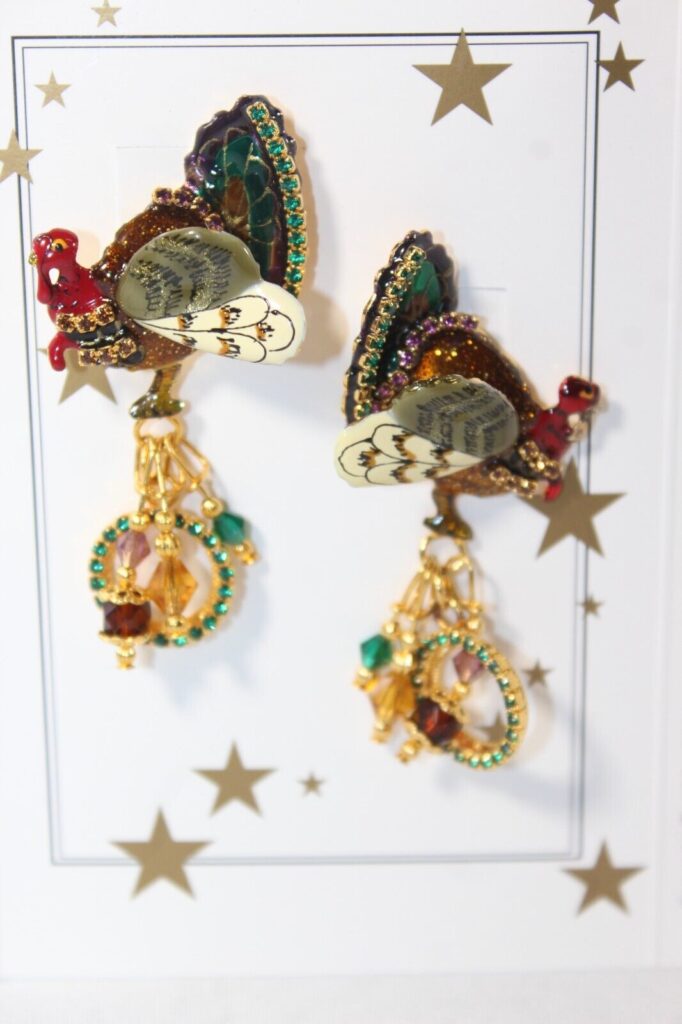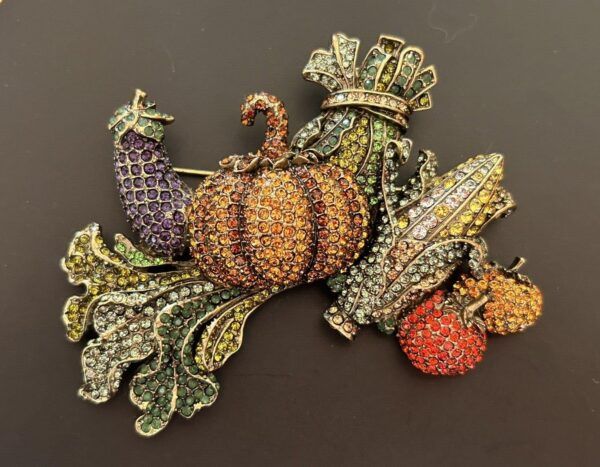#Thanksgiving #Jewelry #WorthPoint
We might be in the minority these days, but in my home, no Christmas decorations go up before Thanksgiving—not even the tree. Call me old-fashioned (it wouldn’t be the first time in my vintage-loving life!), but transitioning from spooky time to harvest celebration season and then to winter fun—and the jewelry that goes along with each round of merriment—works for me.
I’ve written about how much Halloween jewelry is worth and have several Christmas jewelry topics on my list to explore in the future. But as much devotion as I give to counting my blessings in the fall, I haven’t given much thought to Thanksgiving jewelry. Well, other than the tried-and-true Napier cornucopia brooch I’ve had in my collection for ages. As I contemplate adding another piece or two to my own jewelry stash, I’ll share what I’ve learned about Thanksgiving-related jewelry, including a few things to watch for (and a few to avoid) regarding this type of celebratory jewelry.
Early Thanksgiving Celebrations and Jewelry
You probably remember from your grade school history lessons that the inaugural Thanksgiving celebration occurred in 1621 when the pilgrims gave thanks for their first successful harvest after struggling to start their lives here in America. Then, in 1863, when the Civil War was dividing the United States, a unifying day of thanksgiving was decreed by President Lincoln at the urging of Sarah Josepha Hale, the editor of Godey’s Lady’s Book. It became a tradition with every president after that, and in 1942, the fourth Thursday in November officially became Thanksgiving Day.
So, at what point in that history did Thanksgiving jewelry come about? Honestly, I can’t find a historical reference to pinpoint it. If you want to look at the cornucopia, also known as the horn of plenty, as the ultimate representation of giving thanks for bounty, the symbolism goes back to Greek mythology when it represented a never-ending supply of food. It evolved over time to signify the appreciation of abundance and the propensity to share one’s blessings with others, and, of course, the symbol-obsessed Victorians incorporated them into jewelry.
The oldest cornucopia pins and fobs you’ll likely run across today date to the mid-to-late 1800s, and ironically, they’re not plentiful. You might occasionally find a small brooch from that era that depicts a modest turkey, too. Overall, though, you’ll find modern interpretations of Thanksgiving symbolism much more readily available.

Brands Known for Thanksgiving Jewelry
When discussing mid-century vintage jewelry, several brands created pieces suitable for Thanksgiving celebrations. Napier made a couple of different versions of cornucopia brooches in the 1950s/1960s. I particularly like those not only because I’m a vintage Napier devotee but because the beads, faux pearls, and other glass elements representing fruit spilling from the gold-plated horns have a unique look that’s a little more upscale than others.
If I wanted a variety of reasonably priced vintage cornucopias, I’d also consider enameled examples marked HAR (Hargo Creations) and pretty rhinestone versions by B. David. Both can usually be found for less than $30, while Napier’s have risen in price to sell for $100 or more now.
Since my taste runs toward making a statement if I’m going to bother wearing jewelry, I would consider two other newer brands for expressing a bold Thanksgiving vibe: Lunch at the Ritz and Heidi Daus. I like these for all types of holiday jewelry, so when I started exploring Thanksgiving options, I wasn’t surprised that their adornment would be appealing.

Lunch at the Ritz marketed several turkey brooches and fun pairs of earrings decorated with the brand’s signature enameled metal and rhinestone accents. Heidi Daus has sold several glittering rhinestone turkey brooches, clusters of harvested vegetables, and at least one cornucopia design. The catch with all of these is that they’ll usually run from $175-300 unless the secondhand adornment gods present an extreme bargain, but I do think these pieces are worth the hunt.
For the record, I would buy any of these brands for resale if the price was reasonable. Other folks like me won’t be wearing Christmas pins for Thanksgiving dinner and will enjoy donning nicer seasonal jewelry like this instead.
Novelty Jewelry for Thanksgiving
Even though it’s not my favorite to wear, I do think that novelty jewelry is fun. It makes a great starter collection for children, and teachers of young pupils sometimes wear these pieces to entertain their classes. Some of the brands of Thanksgiving novelty jewelry include Russ, JJ (Jonette Jewelry), Hallmark, and AJC (American Jewelry Chain Co.). Danecraft even made a few Thanksgiving designs that fall into the novelty jewelry category. Most are made of plated metalwork or colorful molded resin and depict pilgrims, turkeys, and horns of plenty.
You’ll often run across this type of jewelry when you’re out thrifting or digging through bargain bins at flea markets. Many pieces still look great even though they were made in the 1980s and early ‘90s. They’re certainly cute enough to attract attention, but I’d advise thinking twice about buying Thanksgiving novelty jewelry for resale. Most of these little pins don’t sell for more than $5 to $15 apiece, and they do tend to linger unsold much longer than the nicer brands.
The moral of this story is that Thanksgiving jewelry is indeed a thing, and it will remain on my radar. From Victorian treasures to select name brands, I plan on hunting turkeys and gathering cornucopias to wear to celebrate all the blessings of fall—and I’ll share some with my jewelry clientele, too.
Pamela Siegel is a freelance writer and author who has been educating collectors for more than two decades. In addition to three books on topics relating to antiques and collectibles, she frequently shares her expertise through online writing and articles for print-based publications. Pamela is also the co-founder of Costume Jewelry Collectors Int’l (CJCI) and the proprietor of Chic Antiques by Pamela.
WorthPoint—Discover. Value. Preserve.




